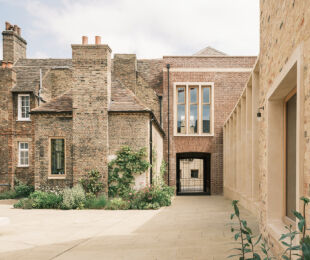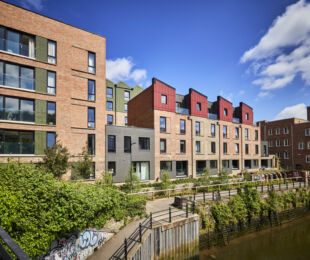
Kirkfell and Caudale are among the first projects to be completed in a sensitive plan to rehouse those residents of the Regent’s Park Estate in Camden, north London, whose homes are being demolished to make way for the HS2 high-speed rail route leading north from Euston Station. The extensive use of brick is an attempt to re-establish traditional built urban forms and materials while also responding to the 1950s estate. The post-war Regent’s Park Estate comprises 2,000 homes in almost 50 buildings owned, or formerly owned, by the borough, which (as the Metropolitan Borough of St Pancras) acquired the site from The Crown Estate in 1951, following the destruction of most buildings in the area during the Blitz.
Architect Mæ identified a number of sites for the Borough of Camden, and following extensive consultations with residents, was appointed to carry out design work for a number of the sites. Phase 1 is now complete and comprises 13 maisonette homes on Robert Street with a community centre and eight dwellings on Varndell Street, together with a new public square and community garden.
Mae’s masterplan, a collaboration with Matthew Lloyd Architects, will eventually provide 122 new homes across eight sites, as well as the refurbishment of the Camden People’s Theatre and conversion of upper floors into flats. The masterplan provides an exemplar for how empty or underused sites can be re-used to provide new homes while also improving the urban setting and enhancing the public realm and amenity, to the benefit of both new and existing residents. “It has become for us a model of how to deliver much-needed housing on small infill sites that abound in London where proposals can both enhance the urbanism and create exceptional, high quality homes’, says Mae. The materials draw on the character of the surrounding buildings, with their concrete ribboned balconies and super-sized chequerboard-faced facades. Light silver granite sets and black asphalt provide a chequerboard pattern in the public square that is civic and playful, and reflects the pattern seen in nearby buildings on the estate. Construction had to meet a tight delivery timetable and budget while achieving a high-quality build.
Kirkfell, on Roberts Street, comprises 13 maisonettes, a new community centre, a new public square and community garden. The horizontal banding of the elevations respond to a 1950s building opposite, designed by architect Armstrong & MacManus and intended “to regain the traditional character of English urban planning which gives a more compact and intimate environment”. Continuous balconies dominate the front serve to ‘extend’ the living rooms to the outdoors. The community centre occupies a corner site, providing a public face to the street and square, connecting to Cumberland market, adding new civic space to the neighbourhood, and opening onto a small community garden behind. The design of the maisonettes reflects Mae’s interest in vertical living and the preferences of residents. The stepped section allows generous 3.2-metre-high first-floor living spaces to the south and a taller space in the community hall at ground level to the north. The dwellings are generously planned, and exceed current standards.
Caudale comprises eight dwellings, three townhouses and five apartments, together with a new public garden. The building also takes its cue from the surrounding post-war estate, described by the vice-chair of St Pancras Borough Labour Party, Eric Cook, as “the ideal site for the careful planning of a great sweep of working-class flats, catering for the main bulk and backbone of our people” – Mae intended their new buildings to serve the same ambition. The ‘bookend’ building form responds to the rhythm of gables along the street, while the exaggerated chequerboard composition of double-height balconies is informed by the elevations on the surrounding late-modern housing designed by Frederick Gibberd. The principal rooms of the generous apartments are designed as an enfilade, with three 'rooms' of equal proportion – kitchen-diner, living room and balcony – aligned and connected though separated by glass screens. Balconies are inset to create the feel of an outdoor room.
The materials draw on the character of the area, with a buff brick echoing the brick of the surrounding estate buildings. A light, heavily textured brick was sought out, with a large variation of colours within the range of white, buff and oak. Each brick was required to display a variation of colour. “The scheme serves as an example of how small urban sites can be used thoughtfully and creatively to meet the mayoral agenda for the development of small sites and produce as many high quality new homes as possible for Londoners”, says Mae.






